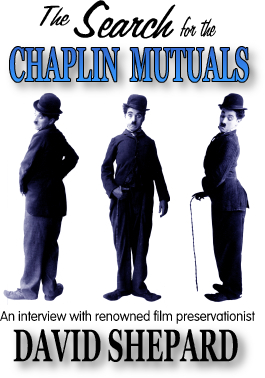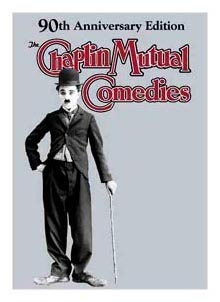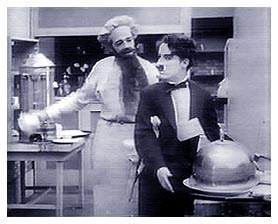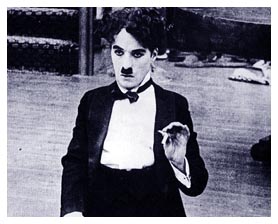

During the June, 2006, Broncho Billy Silent Film Festival in Niles, CA., renowned film preservationist David Shepard unveiled two of the newly restored 90th Anniversary Chaplin Mutuals with music scores by Carl Davis - "One A.M." (1916) and "The Rink" (1916) giving attendees a preview of the package of Chaplin's Mutual comedies that were scheduled for release just a couple of weeks after the festival. Shepard gave an introduction to each film and addressed some of his most recent work that went into the new releases, but he has been very involved with bringing the Chaplin comedies to home viewers for over 30 years. He has worked tirelessly and persistently over the years to provide the best quality prints and prints that are as true to the originals as possible. I asked Shepard to recount his quest for the definitive versions of the Chaplin Mutuals for "Silents Are Golden" which took him back to his days with Blackhawk Films in the early 1970's.
Blackhawk (the Eastin-Phelan Company in Davenport, Iowa)
had had the Chaplin Mutuals for many years from a variety of prints
that they had gotten over the years - some of them good, some
of them not so good. While I was working for the American Film
Institute in the late 1960's, I came across the fact that the
Chaplin Mutuals and a lot of other films were owned by a company
called Guaranteed Pictures who also worked under the name of Commonwealth
Pictures. I approached the owners about getting access to the
films, and they were in the process of selling the whole library
out to Teleprompter Corporation, so they declined to be involved
but said to talk to  Teleprompter
once the deal was done - which I did do.
Teleprompter
once the deal was done - which I did do.
Teleprompter, I think, had paid a great deal of money for the library and had all sorts of aspirations for it. When they actually got it, they discovered it was of very limited use to their business, which was a regional cable television system around New York. After about three years, they decided they were going to sell the library, and Blackhawk Films bought it. It was something that I set up when I was employed there. Included in that library were the 35mm elements that Commonwealth had on the Chaplin Mutuals which were essentially the Van Buren versions of the films which had been anthologized into three feature compilations - "The Charlie Chaplin Carnival," "The Charlie Chaplin Festival," "The Charlie Chaplin Cavalcade." There were some original negatives, as well. Most of the material was quite good.
So using that material, we upgraded our versions of the films. In some instances, the Van Buren people had cut out all of the intertitles of the films, and in others they had left some. We referred to our own copies of the films and to the prints that had been collected over the years by John Hampton at the Silent Movie Theater in Los Angeles to try and figure out what all the titles would be - and then make replicas in the style that most people think of as the original titles, although they are not the original title styles. But the 16mm copies of the films that were around and had been duped a lot, as well, came from Kodascope libraries, and those carried titles using Cloister initials and Della Robbia text face. That's the way we decided to handle them because that's what people would believe were originals.
But once we put the titles in, the scores that were recorded in the early 1930's didn't fit anymore, so what we did was to repeat passages of music and so on to make those scores fit. And that's how the Chaplin Mutuals were released. We announced all 12 of them at once for Christmas of 1975, because Mr. Eastin knew that once people realized we had all this superior material, the previous versions would be dead as doornails. Those are the versions that Blackhawk distributed on 16mm and subsequently on video.
Republic Pictures also used them when they bought the Blackhawk library - I think about 1979 or 1980. They released the Chaplin Mutuals on their own Republic Home Video label both on VHS tape and on laserdisc as "Charlie Chaplin: The Early Years." Those were all mastered from Blackhawk's 16mm elements. They didn't use the 35mm.
Before Republic had bought the company, Kino International Corporation, which was and is still owned by my friend Don Krim, acquired distribution rights for a limited amount of time under a sub-license from Black, Inc., Mo Rothman, for the Charlie Chaplin feature properties, "The Chaplin Revue," "The Kid," "City Lights," "Modern Times" and so forth. They decided they wanted to do a tour of Chaplin festivals using all of these films, but they also wanted to get the shorts. So Don got some Keystone and Essanay shorts from the Museum of Modern Art - and some from DeFonte Film Laboratories which had some negatives from a company called Kings of Comedy who had added music which was basically two phonograph records played over and over again. They wanted to get the Chaplin Mutuals in the Van Buren versions from Blackhawk.
Well, the Blackhawk people wouldn't deal with Kino, however they did, of course, know and were willing to deal with me. So I acquired right of use of the 35mm elements. These were basically the Van Buren versions, except that I made new main titles and historical titles to precede each one of the films. At that time, when the prints were brand new, before they went into service, I made one-inch videotape masters and began to license them for television through TV Cinema Sales Corporation. I didn't have any idea how they would do, but they are what they are - works of genius, but works of genius in black and white without sound. But the company did all right with them, and we put out those versions on home video, as well, through a company called Media Home Entertainment which distributed laserdiscs through Image Entertainment. This was the beginning of my relationship with Image.
As I recall, I didn't have the rights to put them out that way on video under my deal with Blackhawk, but I made some kind of arrangement with them to split the income, and they were glad for the extra income and gave permission. So that was the first video edition of them - basically the slightly modified Van Buren versions.
The other modification associated with the video release was to slow them down to 20 frames a second which is the right speed - or at least in my opinion is the right speed - and to reprocess the Van Buren tracks through an analog device that existed at that time which was called the Eventide Harmonizer which allowed us to raise the pitch so that when we slowed the music down, we could get the pitch back up and it simply sounded like the orchestra was playing slower - not like you were playing a 78 rpm record at 45 or a 45 rpm record at 33.
 They were in distribution
in that format until 1989, the year of Chaplin's centennial when
I felt that they had earned enough that I owed them more. And,
I wanted to put the rest of the titles back in which also necessitated
completely new scores. So I did put the rest of the titles back
in, but I still was unaware that there were some problems with
the films - we didn't quite get all the titles. I used the material
that we had, and I commissioned new scores from a fellow named
Michael Mortilla who composed and performed them with the best
electronic instrumentation that was available at that time - and
they were distributed that way until 1995.
They were in distribution
in that format until 1989, the year of Chaplin's centennial when
I felt that they had earned enough that I owed them more. And,
I wanted to put the rest of the titles back in which also necessitated
completely new scores. So I did put the rest of the titles back
in, but I still was unaware that there were some problems with
the films - we didn't quite get all the titles. I used the material
that we had, and I commissioned new scores from a fellow named
Michael Mortilla who composed and performed them with the best
electronic instrumentation that was available at that time - and
they were distributed that way until 1995.
In 1995, we were still using the telecines from 1983, but video recording had come a long way. Additionally, of course, the materials used in 1983 were made from the prints. I had learned enough by then about working with film to video that every generation that you can get closer to the original is a vast improvement. It's a more dramatic improvement on video than it is with film. So in 1995, I remastered everything, no longer using prints but going back either to the negatives that were used to make the prints or earlier negatives or fine grains - whatever the very earliest generation was that we had. Since some of the very earliest material was starting to decompose at that time, I knew that it was probably going to be the last chance to use it. So, we did new digital transfers, and Mortilla re-did his music. I was able to do a few additional fixes. I had discovered, for example, that the Van Buren version of "The Vagabond" had been considerably re-edited, and I was able to get the film back into the original order. And those 1995 versions came out first on laserdiscs and then in the very earliest years of DVD. They were the very first things I think we ever did to DVD. They've been in distribution from that day until this, essentially.
Then one day when I was in Paris at the Chaplin office, Carl Davis, who was an old friend of mine and with whom I had worked years before on the television series "Hollywood," happened to be there, as well. We talked about the idea of doing some live concert performances with new scores that he would compose using video projection. It's so difficult sometimes going to a situation where an orchestra exists but film presentations probably do not - and films that don't run at sound speed, that don't have standard apertures and all those kinds of issues. So we decided that would be a good thing, and he wrote a score for "The Immigrant." We discovered that people didn't want to perform to projected video, so we began to make 35mm prints - about two a year, and he continued to write scores.
So now, of course, he's done all 12 films and is performing them quite often. I've made 35mm prints, which stay in London, and he uses. The British Film Institute was interested in releasing the material on DVD, and they were prepared to help with the cost of recording and synchronization to the 1995 transfers although I took the opportunity to upgrade some of the films further such as the films we ran last night. They were prepared and released on DVD in England by the BFI who hired Kevin Brownlow to do some additional changes and fixes based on some vintage 16mm prints which he had. The BFI versions came over here, and I used them as templates to align Carl Davis' music with our original or new NTSC transfers. So the material was completed incorporating some of Kevin Brownlow's changes and deciding not to incorporate some of his other changes and adding something here and there I thought he might have overlooked.
All 12 Mutuals are packaged together with two other special features - one of them is a documentary film called "Chaplin's Goliath" that was made in 1996 for Scottish television by Kevin Macdonald. It's about Eric Campbell. The other is "The Gentleman Tramp," the film that was directed by Richard Patterson and produced to go with the 1972 release of the features. The rights for that have reverted to Roy Export of Chaplin's estate. Richard Patterson did a lot of restoration on this feature - upgraded the quality of the clips, upgraded the sound, and did the preparation of it for DVD. Roy Export licensed the film to us. That will be an extra in that box, and it will only be available that way. It will not be available as a single.
I asked Shepard to repeat for "Silents Are Golden" readers some of the comments he made prior to the Chaplin screenings at the Broncho Billy Festival regarding his discovery of additional footage for the films he previewed.
There had been another set of the Mutuals, Essanays and
Keystones prepared for Mo Rothman about 1973 when he started distributing
the Chaplin features and thought  he
could make more money if he had more films to sell. He worked
out some kind of arrangement with the British Film Institute and
put material from them on videotape in England - varying material
- some of it excellent and some of it not that excellent. The
reason he went with the videotape was to handle the speed adjustment.
The BBC had the only way you could run film at variable speed
in the early 1970's - a device called the Polygon. We used to
call it the flying ashtray. It had an eight-sided prism and would
dissolve one frame into the next.
he
could make more money if he had more films to sell. He worked
out some kind of arrangement with the British Film Institute and
put material from them on videotape in England - varying material
- some of it excellent and some of it not that excellent. The
reason he went with the videotape was to handle the speed adjustment.
The BBC had the only way you could run film at variable speed
in the early 1970's - a device called the Polygon. We used to
call it the flying ashtray. It had an eight-sided prism and would
dissolve one frame into the next.
Rothman had these Polygon transfers done and recorded essentially 16mm kinescope negatives from these videos and put in nice careful reproductions of the original titles. He then used the 16mm negatives to make 16mm fine grains and did Kinescope recordings from that to 35mm negatives and had music added. The "One A.M." version which was included in the Rothman series included extra footage of quite different quality from the rest of the film spliced in - and that was my first clue that extra footage did exist.
So I went to the British Film Institute to inquire where it came from, and they told me it was the Royal Film Archive in Belgium. I had done them a nice favor three or four months before - and most unusually in the archive world, they remembered the favor. They sent me the original 35mm print that had all the extra footage. You may have noticed on "One A.M." that I preserved the main title as a way of telling scholars that this was real original material, and that these scenes really had been in the movie. Now I don't whether they were only in the foreign negative, when they had been cut, or why they had been cut. They certainly were gone before the Kodascope prints were made in 1925. We don't know whether Chaplin cut them or some distributor cut them. They were very well cut in the sense that the technical editing was good enough that, in looking at the film, you couldn't tell in the short version that anything had been excised. But here was this beautiful material, so I put it back.
The Australian material I found was in the hands of a private collector, and he had two films - "The Rink" and "The Immigrant." I traded him a new 35mm safety print of "The Rink" for his nitrate print - he was thrilled. We had the nitrate print sent to Paris and a new negative made there. Recently, after this project was all done, within the last couple of months, I got all the Mo Rothman versions, all of their 35mm and 16mm negatives. Now I'm going to be able to go through all the rest and see if there are any additional bits and pieces in the other films so that if we ever decide to go back to them again, we'll have the benefit of the BFI material.
I tried hard to get the BFI material myself in 1998 when I was working on the Essanays. They were very nice and said they'd be glad to cooperate, but nothing happened, so I proceeded without their assistance or their elements. But now we know what they have because we have all the Rothman materials. So if I ever go back to the films again, I'll have that. And more than that, I've sort of been informed that the materials that came down to Van Buren in 1932 had been cut and altered which I didn't know. I would have assumed since they came from original negatives and fine grains and beautiful elements that they were, in fact, authoritative versions of the films. It took me a long time to realize that there are no authoritative versions of the films. I don't think they've changed much since the mid-1920's, but I think they changed a lot between 1916 and that time.
